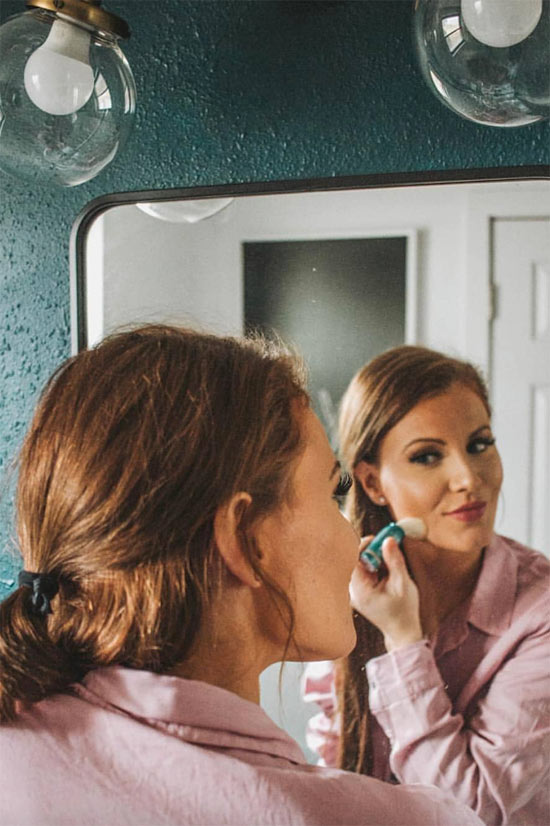It’s very nearly summer, so let’s talk about powder sunscreen – one of the most unique ways of protecting your skin. Sunscreen is critical in preventing sunburn and skin cancer, and on the vainer side of things it’s the best product for keeping the skin wrinkle-free, but do sunscreen powders work as well as oily sunscreen lotions?
Below, I explain exactly what powder sunscreen is, as well as its special benefits. I explain how powder SPF compares to liquid and cream sunscreens and help you understand when to use which. To finish things off, I address some safety concerns you might have and then give the most thorough instructions for applying powder sunscreen along with some useful tips and tricks.
In this article:
- What Is Powder Sunscreen?
- Powder Sunscreen Benefits
- Liquid Vs. Powder Sunscreen: When to Use Which?
- Is Powder Sunscreen Safe?
- How to Use Powder Sunscreen
- Powder Sunscreen Tips
What Is Powder Sunscreen?
Powder sunscreen is exactly what it sounds like. Powder sunscreen is a powder similar to a translucent makeup powder that provides sun protection. The sunscreen protection comes from zinc oxide occasionally combined with titanium dioxide.
These two mineral ingredients are able to provide high level of protection from both UVA and UVB rays. They are the most popular SPF ingredients you’ll see in sunscreens from natural brands. They come in a dry, powdery form and are dispersed in a cream to form a sunscreen. Instead of a dispersing them in a cream, the new innovation is to mix them with other dry ingredients in order to make a powder that protects from the sun.
Powder sunscreens usually have a slight mattifying effect on the skin, and they can come either tinted to fit particular skin tones or translucent in order to work with most skin colors. They usually come in a container with a brush or sponge applicator built in for an easy application on the go.

Powder Sunscreen Benefits
Apparently, this innovative face sunscreen has quite a few benefits, which are:
• Doesn’t Feel Greasy or Heavy
Unlike cream sunscreens, a powder SPF doesn’t feel greasy on the skin. Instead, it actually has a dry, nearly invisible finish and a weightless feel.
• Easy to Apply over Makeup
Re-applying sunscreen on top of makeup is basically impossible with a cream sunscreen. A powder SPF sits on top of makeup beautifully, and can even help boost the coverage and longevity of your look.
• Mattifies the Skin
Powder SPF can absorb excess oils from the skin, leaving it looking matte. This is especially great for those who have oily skin, as it’ll prevent you from looking shiny even on hot days.
• Sets Foundation
Your powder SPF can easily double as your setting powder! You can apply it to your skin after you’ve put on foundation and it will help absorb excess moisture from your makeup while also waterproofing it. This will ensure that your foundation doesn’t fade or smudge throughout the day.
• Doesn’t Dilute or Interfere with Other Sunscreens
It’s a complicated game to put one kind of sunscreen on top of a different kind, as the different sunscreen ingredients will not play nicely with one another and might end up canceling each other out or diluting each other, thereby reducing your protection. This is not an issue with powder sunscreen, since it doesn’t mix with the layers below it. Instead it creates a brand-new layer of protection.
• Non-Comedogenic
It can be very tough to find a liquid sunscreen that won’t cause breakouts (although they do exist), but powder SPF products are almost always non-comedogenic. If your skin gets clogged at the drop of a hat then definitely invest in a powder sunscreen.
• Great for Sensitive Skin
A liquid sunscreen formula is a complex thing that will contain a variety of preservatives and emulsifiers. Often sunscreens will also contain alcohol and fragrances. These ingredients, along with the sunscreen chemicals themselves, can irritate the skin, especially since the thin formulas can penetrate through the top layers of the stratum corneum.
Powder SPF formulas are much simpler since they are free of liquids. They don’t require any of these potentially irritating ingredients, and as a result they are unlikely to cause allergies, contact dermatitis, or any other types of irritation.
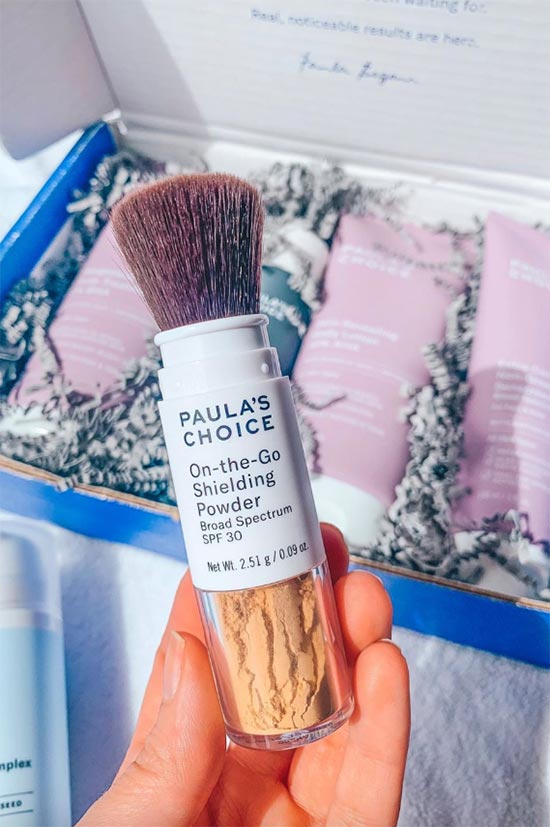
Liquid Vs. Powder Sunscreen: When to Use Which?
I’ve hyped up powder sunscreen quite a bit so far, so it’s quite important that I address this. Unfortunately, powder SPF is no replacement for your cream or liquid sunscreen. I know, I’m sad about it too.
Creamy sunscreens are often just so heavy and gross, while liquid ones contain so much alcohol that they make my eyes sting. Powder SPF, in comparison, is as good as makeup, with a matte, unobtrusive finish and the ability to make me less oily!
But here’s the thing: for a sunscreen to offer full protection it must be used at around 2mg per square centimeter of skin, which roughly equates to a ¼ teaspoon for the face. Any less than that and the reduction of SPF is exponential.
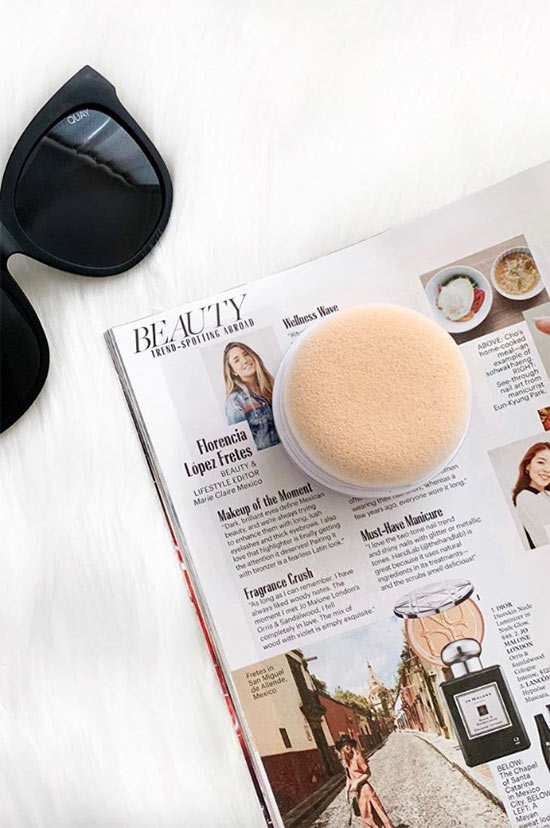
If you only use ⅛ teaspoon you’re not getting half the coverage – you’re getting a third of it. This is why you can’t rely on your foundation for sun protection; if you were to use a full ¼ teaspoon of foundation your face might be protected but your makeup will look like a cakey mess.
Cream and liquid sunscreens sink a little bit into the skin after they’re applied, so it’s easier to apply multiple layers of them. Powders, however, do not sink into the skin. A quarter teaspoon of cream sunscreen already feels like a lot of product, but a quarter teaspoon of powder will turn your face into a cakey, powdery mess. In addition to that, powders are simply harder to control so you’ll have a very tough time ensuring that your whole face is covered evenly.
This is why it’s important to always start your day with a layer of cream sunscreen under your makeup. This layer will provide you with a base of coverage that will keep you protected for a couple of hours of direct sun exposure.
I recommend Stephen Alain Ko’s method of applying a ⅛ tsp of sunscreen, waiting five minutes, and then applying a second ⅛ tsp layer. However, after 4-6 hours some of this sunscreen will naturally fade from yourself even without any exposure to the sun, which is why touch-ups are so important. You will find that this is much easier to do with a light, elegant sunscreen like one of the ones I recommend here.
Later on, in the day you can use powder SPF as a reinforcement or touch-up product, especially if you’re wearing makeup. Chances are that you will only apply enough powder SPF to gain about 45 minutes of protection (going by calculations from Michelle at Lab Muffin), but this might be all you need to protect yourself when heading back home from school or work.
On days when you’ll be out in the sun all day long it is better to skip the makeup altogether and to apply a cream sunscreen every two hours so you can get full protection each time you reapply. Additionally, it’s better not to rely solely on your sunscreen for protection: wear a hat, sunglasses, and stay covered with light but long-sleeved clothing.
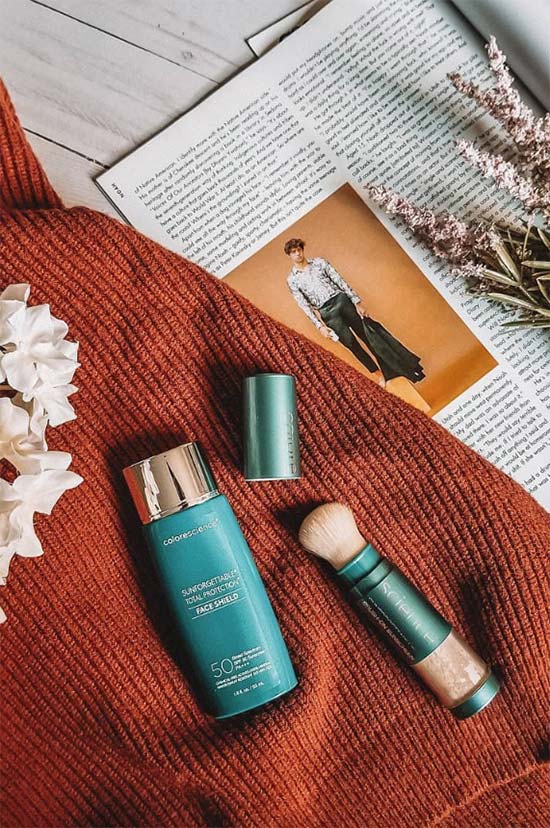
Is Powder Sunscreen Safe?
There are two safety concerns worth discussing when it comes to powder sunscreens. The first is whether they actually work. After all, the only thing more dangerous than not wearing sunscreen is wearing an ineffective one while thinking you’re protected.
For a very long time the US Food and Drug Administration (FDA) would not approve powder sunscreens but earlier this year they changed their tune. Nowadays, companies wanting to sell powder sunscreens in the US have to provide the FDA with additional data proving their efficacy, so we actually know that powder SPF is safe, well-researched, and well-regulated.
The second is regarding inhalation. The concern comes from the (fairly low) cancer risks of inhaling the active sunscreen ingredients: zinc oxide and titanium dioxide. The inhalation concerns apply primarily to nano version of these minerals, though in powders they are usually micronized (i.e. slightly bigger) and therefore less dangerous.
Beyond that, the initial concerns didn’t pop up because of cosmetic powders or sunscreens, they started because people who were inhaling these minerals day in and day out in their workplaces were experiencing ill effects. Occasionally inhaling a small amount while applying your powder SPF shouldn’t pose a risk.
However, as with any powder product, you do want to be careful not to inhale your powder sunscreen when you apply it. The application only takes a few seconds, so holding your breath shouldn’t be a problem.
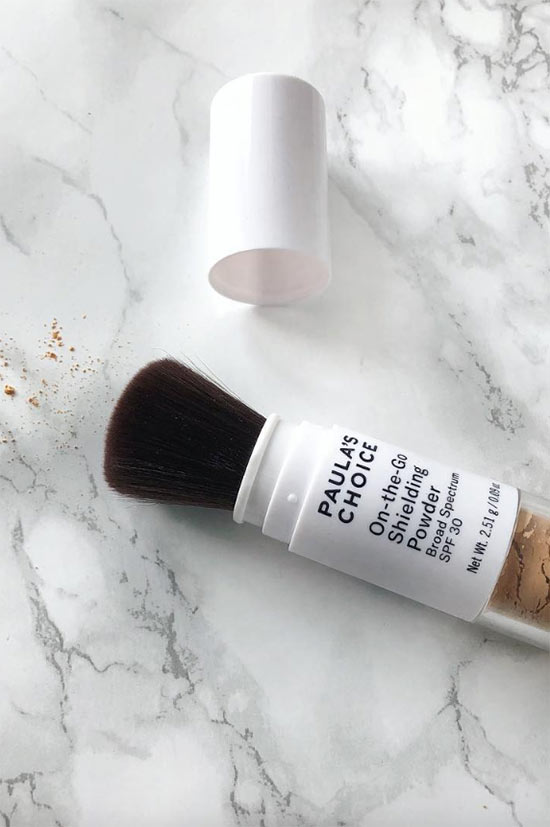
How to Use Powder Sunscreen
Since it’s so difficult to get even initial protection from a powder sunscreen, it is best to use them for touch-ups throughout the day, especially if you’re wearing makeup. They are best for the face and neck, but achieving high protection from them on the rest of the body is difficult and therefore not recommended.
- Apply Cream Sunscreen
You always want to start your day with a base layer of cream or liquid sunscreen, using a full ¼ teaspoon to cover the whole face. Wait 5-10 minutes to allow your sunscreen to sink into the skin a little bit and to become drier.
- Apply Your Makeup
You can follow that up with your typical makeup application, being careful to use stippling motions that won’t drag or remove any of your sunscreen. Once it’s time to set your makeup you can use your typical setting powder or use your brand-new powder SPF.
Technically, sunscreen should be reapplied after two hours of direct sun exposure. However, if you’ve been indoors most of the day you should still put on more sunscreen before heading out since some of your sunscreen will have rubbed off throughout the day. - Apply Your Powder SPF
To use your powder SPF, first dispense some of it on your applicator of choice. For built-in brushes this means shaking it a bit, pressing down on the brush, or pressing on a button at the bottom to saturate the brush with powder.
If you’ve decanted your sunscreen, then dip your brush into the container it’s in. - Use a Pressing Motion
Apply the powder sunscreen in a pressing motion rather than a dragging one, and make sure your areas of application overlap. Do so methodically, making sure to cover the whole face, and pay special attention to the high points of the face like the forehead, cheeks, and nose, as they are going to absorb more UV than other parts of your face.
- Apply Another Layer
Apply a second layer if you feel like you need extra protection.
Powder Sunscreen Tips
- While some people love the built-in brush contraptions that powder SPF comes in, for others they can be difficult to use. If the container is not working for you simply decant the powder into a different container (I’m partial to these) and apply it with your favorite face brush.
- One of the best uses for powder sunscreen is in the hairline and along the part. A regular sunscreen will get on your hair and make it and your scalp feel greasy, while a powder sunscreen will actually absorb oils from your scalp while providing protection, almost acting like a dry shampoo.
Photos via @colorescience, Instagram

